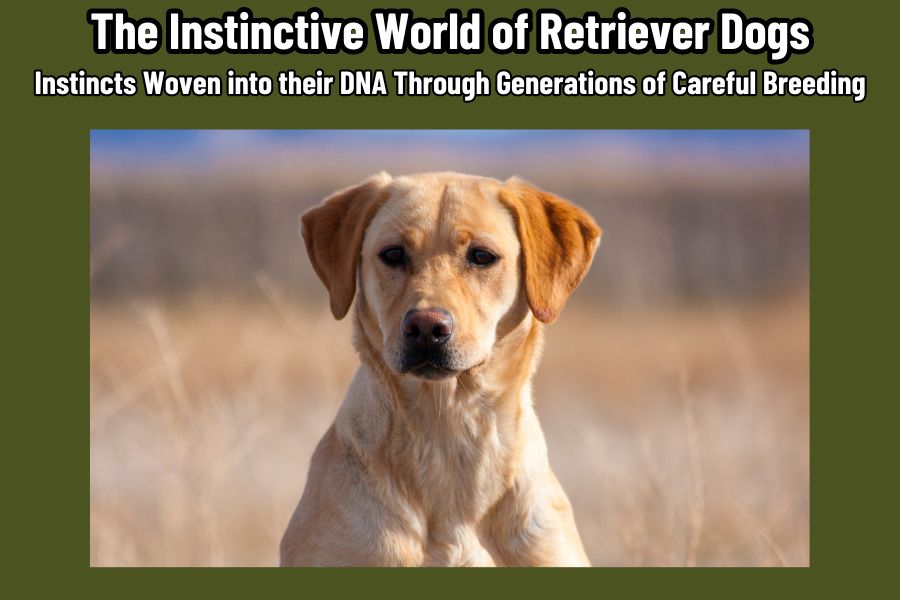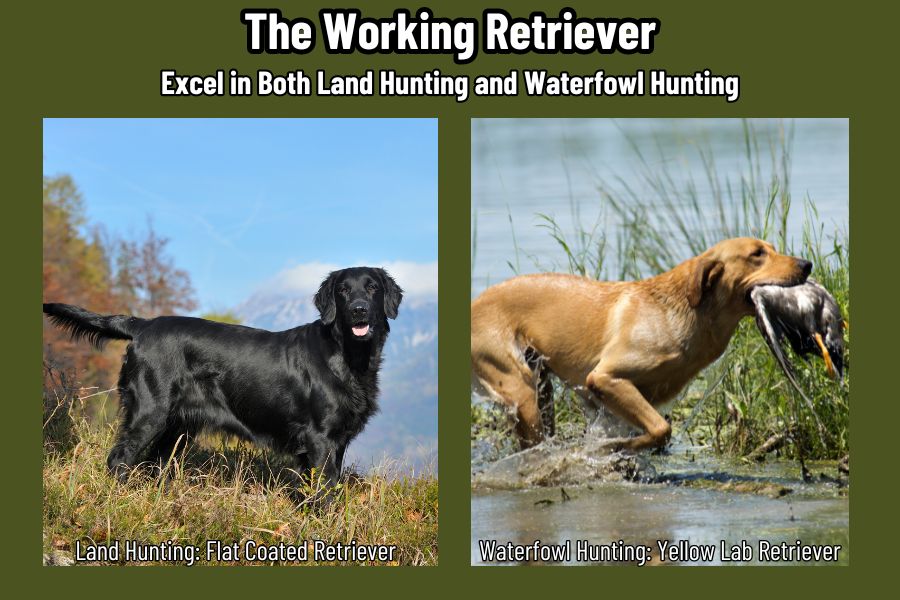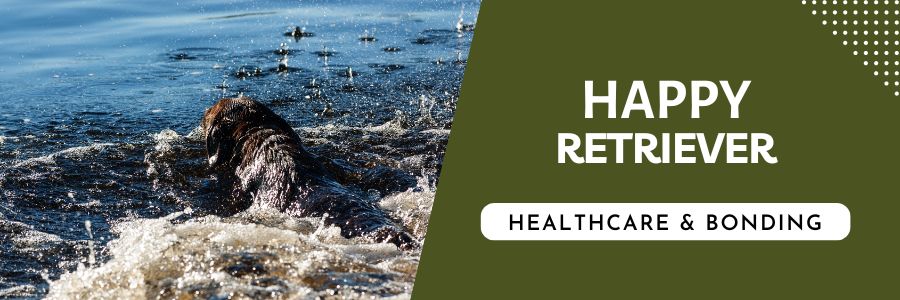Explore why retriever dogs are the ultimate hunting partners in our comprehensive guide. We’ll uncover their rich history, innate retrieving instincts, and why they excel in both land and waterfowl hunting. Learn about their unique traits, best qualities and why retriever dogs are among the most popular and versatile hunting breeds today.
Introduction
Imagine a crisp, early morning by the lakeside, the mist still hanging low over the water. As the sun peeks over the horizon, a loyal figure waits patiently by your side, alert and eager. This is a typical scene for any hunter with a retriever dog, a breed synonymous not just with the sport of hunting but with an enduring partnership that spans centuries.
Retriever dogs have carved their niche not only in the hearts of those who cherish outdoor sports but also in the annals of hunting history. Originating from a diverse lineage tailored specifically for retrieving, these dogs have an impressive legacy that traces back to the waterfowl hunters of Europe and North America. Known for their exceptional ability to retrieve game from both land and water, retrievers have become essential partners to hunters across the globe.
Join us as we delve into the rich history and the remarkable attributes that make retrievers some of the best gun dogs, let’s begin.
The Instinctive World of Retriever Dogs

In the world of hunting, retriever dogs stand out not just for their friendly demeanor but for their deep-seated instincts that make them exceptional at what they do. These instincts are not merely learned; they are a part of the retriever’s very essence, woven into their DNA through generations of careful selection and breeding.
Understanding the Fetch Instincts of Retrievers
Why do dogs like to fetch? Retriever dogs are born with a natural urge to fetch and return objects, a trait that is evident even in young puppies. This instinct is what originally made them invaluable to hunters who needed reliable dogs to retrieve game without damage. The key to this trait is their ‘soft mouth’—a term used to describe the ability of the dog to carry game gently without puncturing it. This ability ensures that the retrieved game is undamaged and suitable for both the trophy and the table.
What makes retrievers unique is not just their physical ability to retrieve but their psychological inclination to please their handlers. This desire to cooperate is deeply ingrained in their temperament and is a driving force behind their trainability and effectiveness as hunting partners.
The Selection and Breeding History that has Honed the Fetch Instincts of Retrievers
The development of retriever breeds is closely tied to the demands of hunters and the environments in which they hunt. The evolution of these breeds can be traced back to the 19th century in the United Kingdom and North America, where hunting sports were a popular pastime among the elite.
Different breeds of retrievers were developed to suit different types of terrain and hunting. For example, the Labrador Retriever, one of the most popular breeds in the world, was refined from St. John’s water dogs, which were known for their proficiency in water and their rugged, weather-resistant coat. Similarly, the Golden Retriever was developed in Scotland for its abilities both in water and on land, combining the best traits of several breeds to create a versatile and resilient hunting dog.
These breeding efforts were not just about enhancing physical traits but also about reinforcing the behavioral characteristics that make retrievers so beloved. Breeders focused on enhancing the dogs’ natural retrieval instincts and their eagerness to please, traits that are highly prized in hunting scenarios.
Through a mix of natural instinct and selective breeding, retriever dogs have become synonymous with the very best of hunting companions. Their history is a testament to the centuries-old relationship between humans and dogs, a partnership that has been both nurtured and honored through the development of these remarkable breeds.
The Working Retriever

In the diverse world of hunting, retriever dogs or working retrievers are renowned for their versatility and adeptness. In this section we’ll explore how these skilled canines excel in both land hunting and waterfowl hunting.
Land Hunting
On land, retrievers demonstrate exceptional abilities that extend beyond simple fetching. Their keen sense of smell enables them to track and retrieve game across various terrains, from dense forests to sprawling open fields. This skill is particularly vital when pursuing game like pheasants, quails, and other land birds that may take refuge in thick underbrush or tall grass after being shot.
Waterfowl Hunting
Waterfowl hunting is where retrievers truly distinguish themselves, epitomizing their breed’s characteristics and historical background. Equipped with water-repellent coats and webbed feet, these dogs are natural swimmers, adept at retrieving ducks, geese, and other waterfowl from bodies of water. Watching a retriever navigate through water with grace and determination, diligently fetching game, is both iconic and a testament to their specialized breeding.
Why Retrievers Make Great Hunting Dogs?
Retriever dogs are celebrated not only for their proficient retrieving skills but also for a set of intrinsic physical and behavioral traits that make them ideal for hunting. These characteristics have been honed over generations, making retrievers not just effective but preferred companions in the hunting field. In this section, we’ll explore the physical and behavioral attributes that distinguish retrievers as top-notch hunting dogs.
Physical Traits Common to Retriever Breeds
Retrievers are known for their robust physical attributes that suit the demanding nature of hunting:
- Size: Typically medium to large, retrievers are the perfect size for robust activity without being cumbersome. Their stature allows them to handle both the physical demands of swimming and the endurance needed for long days in the field.
- Coat: Their coats are uniquely adapted for the environments they work in. Water-resistant, dense, and sometimes oily, the coats protect them from cold waters and harsh weather, making breeds like the Labrador Retriever and Golden Retriever perfect for waterfowl hunting.
- Eyesight: While not as visually reliant as sighthounds, retrievers have keen eyesight important for marking downed game and following handler signals from a distance.
- Memory: One of the more remarkable traits is their excellent memory, vital for recalling specific training and commands during hunts, and remembering the location of downed game.
- Hearing: Their acute hearing allows them to pick up subtle sounds of wildlife in their vicinity, enhancing their ability to locate and retrieve game effectively.
- Nose: While not as refined as that of dedicated scent hounds, the retriever’s nose is still quite proficient, enabling them to track wounded game over moderate distances.
- Soft mouth: Perhaps their most defining physical trait, a retriever’s soft mouth allows them to fetch and carry game without damaging it, a critical requirement for any hunting dog.
Behavioral Traits Common to Retriever Breeds
The behavioral characteristics of retrievers truly set them apart as ideal hunting partners:
- Gentleness: Their gentle disposition makes them easy to work with both in the field and at home, a trait that also ensures the careful handling of game.
- Patient Nature: Patience is key in hunting, and retrievers exhibit this trait both while waiting for commands and when working slowly towards a scared or injured game.
- Willingness to Please: Retriever dogs have a natural desire to please their handlers, which translates into enthusiastic and focused work during hunting.
- Desire and Drive: They possess a high energy level and drive, eager to take on tasks and persist until they are complete.
- Biddable: This refers to their ability to take instruction well, a crucial trait for the complex training required for hunting.
- Hardiness: Retrievers are tough and can withstand both physical and environmental challenges, essential for hunting in various climates.
- Love for Water and Trainability: Their affinity for water is unparalleled, and coupled with their high trainability, it makes them excellent for retrieving from lakes, rivers, and swamps.
These physical and behavioral traits not only make retriever dogs excellent hunting dogs but also beloved family members. Their capabilities and temperaments align perfectly with the needs of hunters in the field and at home.
Retriever Breeds: The Most Popular Hunting Dogs

Retriever dogs are among the most cherished and sought-after gun dog breeds worldwide, praised for their versatility, intelligence, and agreeable nature. Each breed within the retriever family brings unique traits and histories endeared by hunters and dog lovers alike. Here, we explore some of the most popular retriever breeds, their origins, and what makes each distinct.
Chesapeake Bay Retriever: The Tough and Tenacious
Origin and History: The Chesapeake Bay Retriever, affectionately known as the Chessie, traces its roots back to the 19th century in the Chesapeake Bay area. The breed was developed from two Newfoundland puppies who were rescued from a shipwreck off the coast of Maryland. These puppies were bred with local retrievers and hounds to enhance their skills in water retrieval, leading to the robust and resilient Chessie known today.
Characteristics: Chessies are known for their strength, protective nature, and endurance. They have a distinctive oily coat that provides excellent insulation and water resistance, making them superb waterfowl hunters. These dogs are intensely loyal and somewhat aloof with strangers, making them excellent watchdogs as well as hunting companions.
Curly-Coated Retriever: Multipurpose Hunters
Origin and History: The Curly-Coated Retriever is one of the oldest retriever breeds, with its development in England traced back to the early 19th century. This breed was created by crossing the now-extinct English Water Spaniel, the St. John’s water dog, the Poodle, and possibly the Irish Water Spaniel, to produce a capable and versatile hunter.
Characteristics: Known for their crisp, curly coats, these retrievers are not just eye-catching but also highly practical, as their curls provide protection against brambles and cold water. The Curly-Coated Retrievers are confident and independent, known for their intelligence and problem-solving abilities, which make them standout performers in the field.
Flat-Coated Retriever: The Energetic Enthusiasts
Origin and History: Developed as a gamekeeper’s dog in the mid-19th century in England, the Flat-Coated Retriever was bred from a mix of local retriever breeds, Setter, Sheepdog, and Spaniel lines. This breed quickly became popular for its superb retrieving abilities both on land and water.
Characteristics: The Flat-Coated Retriever is cheerful, optimistic, and friendly. They are characterized by a shiny, flat-lying coat and a long head that distinguishes them from other retrievers. Their boundless energy and eagerness to please make them excellent family pets and tireless hunting dogs.
Golden Retriever: The Gentle Hunters
Origin and History: The Golden Retriever was first developed in Scotland in the late 19th century by Lord Tweedmouth, who aimed to create a breed that was both an adept retriever and a willing companion. The breed was achieved by crossing the now-extinct Yellow Retriever with the Tweed Water Spaniel and later with the Bloodhound and Irish Setter.
Characteristics: Golden Retrievers are celebrated for their friendly and tolerant attitude. They sport a beautiful, dense water-repellent coat, which can be straight or wavy. Known for their intelligence and versatility, Goldens excel in various roles including search and rescue, assistance dogs, and, of course, as beloved hunting companions.
Labrador Retriever: America’s Favorite
Origin and History: Originally from Newfoundland, not Labrador, the Labrador Retriever was utilized by fishermen to help retrieve fishing nets and loose fish. Brought to England in the 19th century, the breed was refined by British breeders and became the Labrador we know today.
Characteristics: Labradors are known for their friendly nature, high intelligence, and adaptability. They have a short, dense, water-resistant coat, and a famous “otter” tail which serves as a powerful rudder in the water. Their excellent disposition and trainability have made them the most popular dog breed in several countries.
Nova Scotia Duck Tolling Retriever: The Toller
Origin and History: The youngest of the retriever breeds, the Nova Scotia Duck Tolling Retriever, was developed in the early 20th century in Nova Scotia, Canada. Tollers were bred to both lure ducks into range and retrieve from the water, performing tasks that typically required separate breeds.
Characteristics: Tollers are the smallest of the retriever breeds but are known for their high energy and powerful hunting instincts. They have a dense water-repellent coat and are extremely agile. Their unique hunting style involves playing along the shoreline to spark curiosity among ducks, a method known as “tolling.”
Each of these retriever dogs brings a rich history and a set of traits that not only make them excellent hunting dogs but also a treasured member of the family.
Training Techniques for Retriever Dogs

Training retriever dogs is both an art and a science, requiring patience, consistency, and an understanding of the dog’s natural instincts and abilities. From the early puppy stages through to advanced training, the techniques used can significantly impact the effectiveness and happiness of both the dog and the handler. Here, we explore the foundational and advanced training methods essential for developing a top-notch retriever.
Fundamentals of Training a Retriever
Retriever training starts from the moment you bring your puppy home. Early training focuses on socialization, basic obedience, and establishing a bond of trust and respect. Puppies are taught simple commands such as “sit,” “stay,” “come,” and “heel.” These early lessons are crucial as they form the building blocks for more complex tasks later on.
An interesting tradition in “retriever training” for land hunting involves the use of various dummy objects that simulate different game weights and textures. This practice trains the dogs not only to handle different types of game with care but also to adapt their retrieval tactics based on the terrain and nature of the hunt.
Traditional “retriever training” techniques for water include “water marks,” where trainers use shot dummies to mimic hunting scenarios. This teaches the dogs to observe where the “game” lands and retrieve it precisely, demonstrating their specialized skills and training.
In the beginning stages of fetch dog training it’s important to encourage the retrievers natural retrieving instincts while also teaching them to handle objects with care.
Advanced Training: Signals, Commands, and Tasks
As retrievers mature, their training progresses to more advanced levels that fine-tune their skills and prepare them for actual hunting scenarios. A good retriever must be trained to understand and perform these tasks :
- Hand Signals: These are crucial for directing a dog in the field, especially over long distances where verbal commands might not be heard. Training involves associating specific hand gestures with directions or actions.
- Verbal and Whistle Commands: Verbal cues are combined with whistle signals to control the dog’s movement and actions from afar. Different whistle patterns can signal commands like returning to the handler or stopping on the spot.
- Steadiness: A key skill for hunting dogs, steadiness involves the dog remaining calm and in place until released. This prevents premature flushing of game.
- Mark Shot Game: Retrievers are trained to watch where game falls and remember the location for retrieval. This requires keen observation skills and mental mapping abilities.
- Blind Retrieve: Retrievers must often retrieve game they did not see fall. Training for blind retrieves involves guiding the dog with hand signals and whistles to the area of the fallen game.
- Retrieve to Hand: Dogs are taught to bring the game back directly to the handler’s hand, ensuring that the game is delivered undamaged and without being dropped along the way.
- Honing: Refining the dog’s retrieval skills to increase precision and efficiency.
- Shake on Command: Teaching the dog to shake water off only on command after retrieving from water, preventing soaking the handler or equipment.
- Quarter: The dog learns to move back and forth in front of the hunter within gun range, ensuring thorough coverage of an area.
- Steady to Wing and Shot: The retriever must remain calm and steady during the excitement of birds rising and guns firing, only moving to retrieve once commanded.
Advanced retriever training requires repetition, patience, and gradual increase in complexity. The goal is not only to harness the retriever dogs natural abilities but also to develop a responsive and controlled partner in the field.
Keeping a Happy Retriever

Ensuring the happiness and health of retriever dogs goes beyond basic care; it involves a comprehensive approach that includes proper nutrition, regular healthcare, and fostering a deep bond between the dog and its family. A happy retriever is not only more effective in the field but also a more content and well-adjusted family member.
Maintaining Your Retriever’s Health and Vigor
The health and vigor of retriever dogs are paramount, both as family pets and as active hunting companions. Here’s how to ensure they remain in top condition:
- Nutritional Advice Tailored to Retrievers: Retrievers are energetic dogs that require diets rich in proteins and fats to support their high energy levels and physical exertion. High-quality dog food that meets the nutritional levels established by the AAFCO Dog Food Nutrient Profiles for adult dogs or puppies (depending on the age of your retriever) is essential. For retrievers that spend a lot of time swimming and in cold weather, additional calories and possibly supplements like fish oil for coat health and joint support may be beneficial. Always have fresh water available, especially after exercise to prevent dehydration.
- The Importance of Regular Veterinary Check-ups and Vaccinations: Regular check-ups with a veterinarian are crucial for maintaining the health of your retriever. These visits not only help catch any potential health issues early but also ensure that your dog stays up-to-date on vaccinations, which protect against common canine diseases. Discuss parasite prevention with your vet as well, since retrievers can be exposed to fleas, ticks, and heartworms, especially in rural and hunting environments.
The Importance of Bonding with Your Retriever
The relationship between a retriever and its owner is built on trust and mutual respect, established through consistent training and integrated family interactions.
- Building a Strong, Trusting Relationship: Be consistent, positive when interacting with your dog. Retrievers are eager to please and respond well to positive reinforcement techniques such as praise, play, and treats. Integrating training sessions with daily activities helps reinforce commands and behaviors, making them second nature to the dog.
- Family Life: Additionally, involve your retriever in family activities to strengthen the emotional bond. The more your retriever feels part of the pack, the happier and more responsive it will be.
Keeping a happy retriever involves a holistic approach focusing on health, training, and a strong emotional connection.
Conclusion
In exploring the world of retriever dogs, we’ve uncovered not only their exceptional capabilities as hunting companions but also the deep emotional bonds that define the relationships with their handlers. These dogs bring unparalleled joy and fulfillment to hunting.
Retrievers are celebrated for their versatility, adeptness in both water and land environments, and an intrinsic eagerness to please that makes them stand out. Whether it’s the Chesapeake Bay Retriever’s tenacity in icy waters, the Labrador Retriever’s enduring popularity, or the Golden Retriever’s gentle approach to retrieval, each breed brings its own unique traits to the field. These characteristics are not merely beneficial; they are essential in various hunting scenarios where the retriever’s skills can significantly impact the success of the hunt.
In summary, retriever dogs are truly indispensable companions in both the wild and the warmth of home.
FAQs: Retriever Dogs
Retriever dogs are a beloved group, known for their versatility and friendly nature. Here, we address some frequently asked questions:
What is the most popular retriever?
Retriever Dogs Answer:
The Labrador Retriever holds the title as the most popular retriever and has also been the most popular dog breed in several countries, including the United States, for many years. This popularity is attributed to the Labrador’s friendly nature, intelligence, and versatility. Labs excel in various roles, from family pets and service dogs to hunting companions and show dogs, making them a favorite worldwide.
What’s the difference between English Lab vs. American Lab?
Retriever Dogs Answer:
The main differences between English Labs and American Labs lie in their physical build and temperament. English Labs, often referred to as British Labs, are stockier, with a broader build, heavier bones, and a more pronounced head. They are generally known for a calmer demeanor and are more commonly used as show dogs or for companionship. American Labs are leaner and more athletic, bred primarily for fieldwork and hunting tasks. They tend to be more energetic and have a high working drive, making them excellent for active roles.
Are curly coated retrievers rare?
Retriever Dogs Answer:
Yes, Curly-Coated Retrievers are considered one of the rarest retriever breeds. Known for their distinctive tight, curly coats, these dogs are one of the oldest retriever breeds, yet they remain less common than other retrievers. Their rarity is partly due to their specific breeding and the dominance of more popular breeds like the Labrador and Golden Retrievers in both homes and competitive fields.
What two breeds make a Flat-Coated Retriever?
Retriever Dogs Answer:
The Flat-Coated Retriever was originally developed from a mix of several breeds, primarily the now-extinct St. John’s Water Dog and the Newfoundland, along with some Setter and Sheepdog bloodlines. These combinations provided the Flat-Coated Retriever with its characteristic cheerful demeanor, intelligence, and an excellent retrieving ability, both on land and in water.
Why are Nova Scotia Duck Tolling Retrievers called tolling retrievers?
Retriever Dogs Answer:
Nova Scotia Duck Tolling Retrievers are named for their unique hunting technique known as “tolling.” This method involves the dog playing along the shoreline to lure curious waterfowl within range of a hunter. The playful actions of the Toller mimic those of a fox, piquing the interest of ducks and geese, which then move closer to investigate, allowing hunters to take a shot.
What is the difference between a Labrador retriever and a Chesapeake Bay Retriever?
Retriever Dogs Answer:
While both breeds are excellent water dogs, there are notable differences. Labrador Retrievers are known for their friendly, outgoing nature and are generally softer in temperament, making them great family pets as well as hunting dogs. Chesapeake Bay Retrievers, on the other hand, are known for their toughness and tenacity. They have an oilier, thicker coat and a more stoic demeanor, traits that make them particularly well-suited to the harsher, colder water conditions of the Chesapeake Bay area where they were originally bred. Chessies are also known to be somewhat more reserved and protective compared to the generally sociable Labs.
Resources: Retriever Dogs
SPECIAL NOTE: “The information provided in this post about retriever dogs is based on research using the Resource links listed below. While we try to keep the information for this post current, there are no representations expressed or implied, about the completeness, or accuracy of the information provided. Therefore all hunters should always verify current information from these resources along with other local and federal publications”.
Online Resources
- American Kennel Club (AKC) – Retrievers
- The Kennel Club (TKC) – Search Breeds A-Z
- United Kennel Club (UKC) – Hunting Retrievers
- Canadian Kennel Club (CKC) – Sporting Dogs
Books
Here are several high-value and popular books specifically about Retrievers that provide a wealth of information on training, care, and the history of these remarkable breeds:
- “The Labrador Handbook: The definitive guide to training and caring for your Labrador” by Pippa Mattinson – This book provides a comprehensive guide to caring for, managing, and training Labrador Retrievers, one of the most popular retriever breeds.
- “The Complete Guide to Golden Retrievers: Finding, Raising, Training, and Loving Your Golden Retriever Puppy” by Dr. Joanna de Klerk – This guide offers detailed information on raising Golden Retrievers, focusing on training techniques, health care, and making the most of your relationship with this affectionate breed.
- “Retrievers: Everything About Purchase, Care, Nutrition, Breeding, Behavior, and Training” by Joe Stahlkuppe – This book covers various retriever breeds, offering insights into their care, training, and behavioral management, making it a great resource for any retriever owner.
These books are ideal for both new and experienced retriever owners, providing essential information to help you understand and better care for your retriever dogs.


